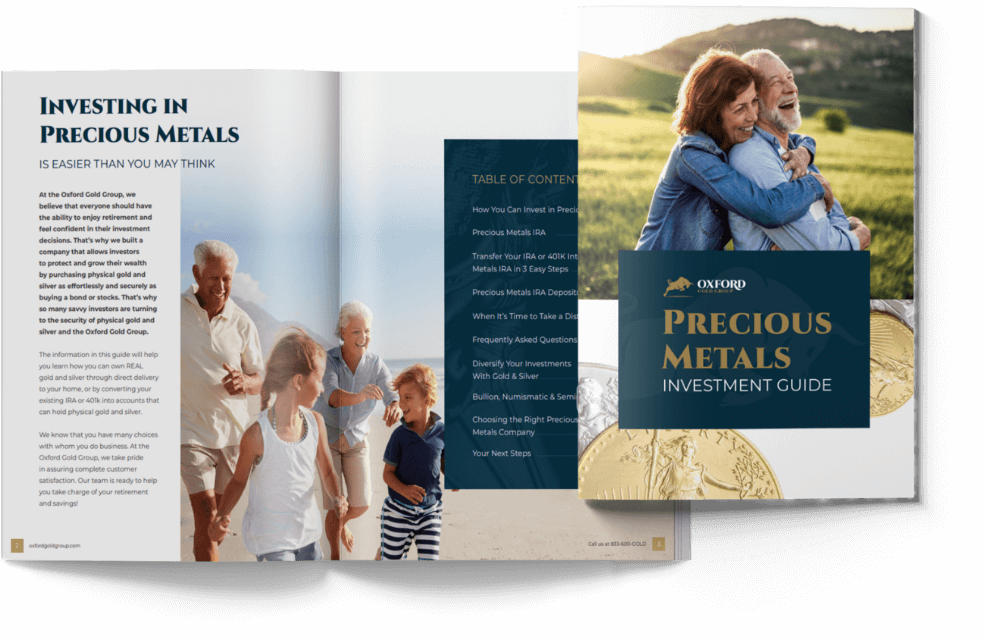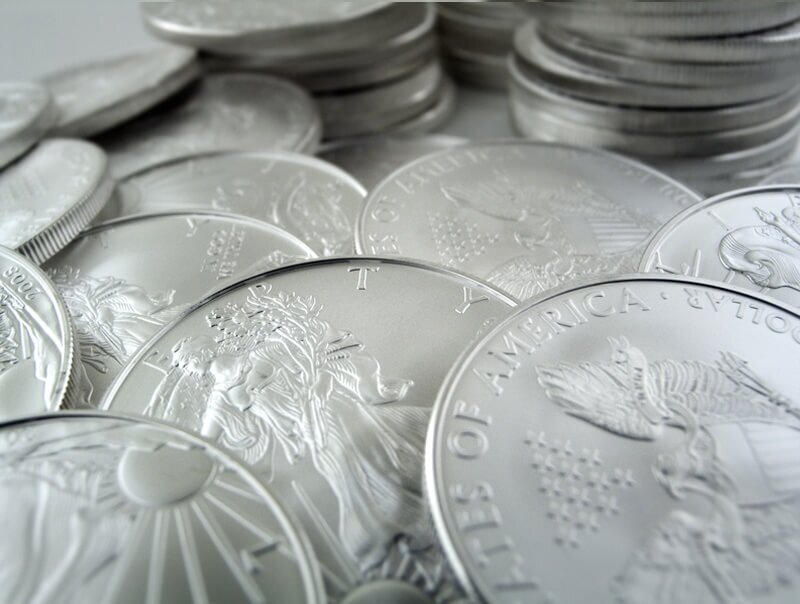
Investing in a silver IRA can help mitigate your portfolio risk, especially during stagflation and other economic crises. If you want to protect your savings against asset volatility, one of our account partners at Oxford Gold Group can help. Contact us today to start investing in a silver IRA.
"*" indicates required fields




An individual retirement account (IRA) is a form of savings account that is similar to 401(k) retirement accounts. You might be familiar with conventional IRAs and the tax advantages they offer.
Two types of IRA accounts exist:
A regular IRA permits investments in paper assets, including equities, bonds, exchange-traded funds, and certificates of deposit (CDs).
On the other hand, a self-directed IRA account lets IRA investors hold a wide range of alternative assets, including commodities, tax lien certificates, real estate, and precious metals.
Gold and silver IRAs are examples of precious metal IRAs, which fall under the category of self-directed IRAs. By opening a silver IRA, you can add physical silver coins and bars to your retirement portfolio.
A silver IRA functions similarly to a regular IRA. As a self-directed IRA, a silver IRA has the same contribution and withdrawal limits as a regular IRA.
Another similarity is that you can choose to set up your precious metals IRA with pre-tax dollars (traditional IRA) or after-tax dollars (Roth IRA).
If you own a Roth IRA, you can’t deduct your contributions from your taxable income. However, you won’t pay tax on your IRA withdrawals when you reach retirement age.
A precious metals IRA that holds tangible assets, such as bullion bars, must meet specific requirements:

What are the reasons for opening a silver IRA account? When you buy physical silver, you buy a precious metal that is not susceptible to decay or corrosion.
Silver derives its intrinsic value as a tangible asset from its role as an industrial raw material. Silver is scarce, homogeneous, and combinable. With these characteristics in mind, let’s examine why you should open this self-directed IRA.
Silver’s tensile strength, ductility, and malleability make this white metal invaluable in the production of batteries, photovoltaic panels, touchscreens, semiconductors, and other products.
Consequently, the ever-increasing demand for renewable energy and electric vehicles is also pushing the demand for silver. However, silver inventories are depleting worldwide, and supply will not be able to keep up with industrial demand for some time to come. In theory, as demand surpasses supply, an increase in silver prices ensues.
Market manipulation and uncertainties, such as pandemics and armed conflicts between countries, can affect the price of silver. However, supply and demand are the key price drivers of silver bullion over the long run, making it a viable asset option for precious metals investors.
Even though no direct and quantifiable relationship exists between the silver price and inflation, the metal has several characteristics that make it a viable option as an inflation hedge.
In other words, whenever inflation or an increase in money supply weakens the U.S. dollar, the price of silver tends to increase, protecting you against a decrease in purchasing power.
Precious metals, including silver, derive value differently than paper currencies. Printing silver bullion is impossible, which means there is a limit to the supply of silver.
Gold has a more prominent relationship with inflation than silver. However, the price of silver follows the price of gold, and if the gold price increases, so will the price of silver. Because of this interaction, silver has an indirect relationship with inflation.
Silver also has industrial applications, and when aggregate demand outraces aggregate supply, causing inflation, an increase in the silver price follows suit.
Don’t keep all your eggs in the same basket.
Silver coins and bullion bars are physical assets and differ inherently from the paper assets that are available through your banker or stockbroker.
Common securities, such as equities, bonds, mutual funds, and annuities, are subject to counterparty and currency risk.
When the third party holding your paper asset defaults on its contractual obligation, you might incur losses. Unfavorable currency fluctuations can cause your security investments, such as bonds, to lose value or income.
On the other hand, silver is a form of tangible wealth that has been a store of value for thousands of years. Adding precious metals IRA accounts to your portfolio can be an effective diversification strategy to reduce risks.
The price fluctuations in the precious metals market are relatively volatile. Because silver is a store of value and an industrial metal, it has more price drivers than some other metals and undergoes more severe price fluctuations.
For this same reason, a silver IRA account has the potential to earn relatively high returns, especially during bear markets and uncertain times. The increase in industrial consumption fuels silver’s demand and value increase.
A silver IRA account might be a viable option if you are looking for an asset class that can potentially achieve significant capital gains.
When you purchase silver bars, coins, or other precious metals in physical form, you are holding collectibles, an asset class that is subject to capital gains tax. You will owe the IRS capital gains tax after selling the precious metal, but only if you held the collectible for longer than one year.
You can choose the applicable tax structure if you want to open a silver individual retirement account.
Contributions to traditional IRAs are tax deductible, which means your income tax obligations before retirement are lower. However, when you retire, you will pay regular income tax on your withdrawals.
If you believe you will be in a higher tax bracket when you retire, you can open a Roth IRA.
You can’t deduct your contributions to a Roth IRA from your taxable income. However, the assets that form part of this account grow tax-free, and you won’t pay tax on your distributions.
A silver IRA and a gold IRA have the same function and structure. Both are self-directed accounts that hold precious metals as “safe-haven” assets, and they offer the same tax benefits.
The differences between gold and silver retirement accounts have to do with the differences between gold and silver as commodities.
Silver has a broad commercial and industrial application range, while investors mainly treat gold as a store of value and inflation hedge.
Silver deposits are also more common than gold deposits, which means that, historically, gold is more expensive than silver. As a lower-cost asset, silver tends to be more volatile than gold. Because silver has a lower price than gold, it is easier for someone to invest in silver.
As a countercyclical asset, gold has an inverse relationship with the stock market and retains its value during economic downturns. Silver has a closer link with the economy but is also an active store of value.
Whether you should fund a gold or a silver IRA depends on your financial situation and investment objectives.


Learning to invest in silver may seem intimidating, but it’s not as it seems. Our team has worked hard to create a short and digestible guide so that you can quickly learn how to make the best decisions for your future.



Under the tax code: 26 U.S. Code § 408, self-directed IRA accounts can hold physical silver, gold, platinum, and palladium. However, physical silver bars and coins are subject to several restrictions.
The types of silver coins and bars permissible under the Tax Code include:
Examples of coins that are eligible to form part of a silver IRA include:
A conventional IRA custodian, such as a bank, typically doesn’t allow the owners of IRA accounts to add physical precious metals to their portfolios. Your IRA funds consist of conventional securities if you have a regular account.
To invest in an IRS-approved precious metals IRA, you need to work with a non-bank trustee that allows account holders to add precious metals to their retirement funds while adhering to all relevant IRS rules.
You can fund your silver IRA with one of two methods:
A direct or trustee-to-trustee transfer is when the account holder instructs the trustee of an existing IRA to make a transfer into a new IRA. No IRS restrictions apply to this funding method, and there is no minimum investment amount.
Direct transfers are only available between IRAs with similar tax structures. For example, you can only transfer funds from a pre-tax account to another pre-tax account. If you want to fund an after-tax account, you can only do a direct transfer from a Roth IRA.
A silver IRA rollover lets you move funds into your self-directed IRA from another type of account, such as a 401(k).
Two types of rollovers are available: direct rollover and indirect rollover.
A direct rollover provides an easy way to move funds directly from your employer’s plan to a new IRA at a different institution. With this rollover type, you don’t need to withhold funds for taxes.
With an indirect rollover, or 60-day rollover, you need to request distribution and take possession of the funds before moving them into your SDIRA.
Under IRS regulations, you must withhold 10% of the funds you distribute from an IRA. If you distribute the funds from a 401(k), 403(b), or a governmental 456(b) plan, you need to withhold 20%.

You can begin withdrawing from your precious metals IRA at the age of 59 ½ without penalty.
Once you turn 72, you must make the required minimum distributions (RMDs). These distributions are withdrawals from your account. In retirement, your withdrawals can exceed the RMD amount.

At the Oxford Gold Group, we can help you convert a regular IRA or employer-sponsored plan into a self-directed IRA that holds precious metals.
Our IRS-approved services aim to provide a personalized and comprehensive investment strategy while providing you with all the information you need to make calculated decisions.
If you want to invest in silver in your IRA, call us at (833)600-4653 or complete our online contact form to request a free investment guide.
By clicking the button above, you agree to our Privacy Policy and Terms of Service and authorize Oxford Gold or someone acting on its behalf to contact you by text message, ringless voicemail, or on a recorded line at any telephone or mobile number you provide using automated telephone technology, including auto-dialers, for marketing purposes. No purchase required. Message and data rates may apply. You also agree to receive e-mail marketing from Oxford Gold, our affiliated companies, and third-party advertisers. To opt-out at any time click here or reply STOP to opt-out of text messages.
"*" indicates required fields

"*" indicates required fields
Inside this Free Investment Guide